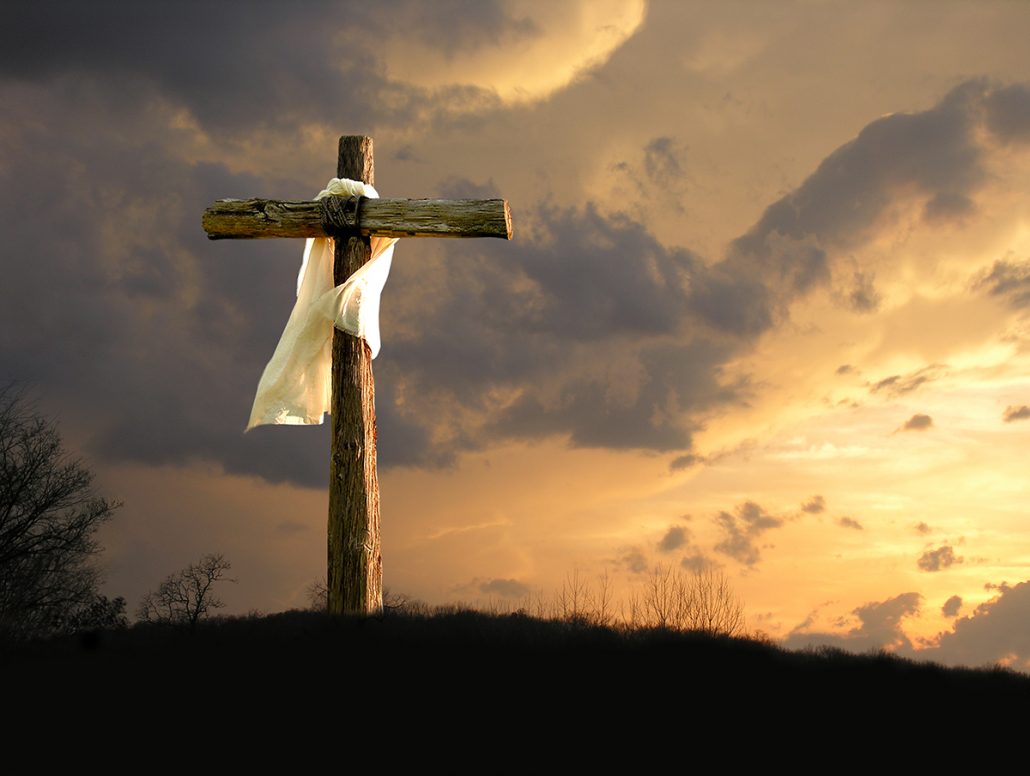In “A Handbook for the Discipline of Lent” the Lutheran author, The Rev. Thomas L. Weitzel, tells us the word “Lent” comes from the old English word “lencten”, meaning “lengthen”, referring to the lengthening of days in the northern hemisphere towards the spring equinox. In the southern hemisphere it is our period leading to autumn, so we need to remember that Israel, where the first Easter occurred, is in the northern hemisphere.
The season of Lent is derived from the ancient Church’s period of preparation for those who were to be baptised at the Easter Vigil. Today, the entire Church uses this same period, as well as some of the practices used then, to prepare for the feast of the Resurrection of Christ. Worldwide, Lent is a time to repent, and to reflect on our Saviour’s sacrifice for the sins of all people.
Lent is 40 days long, not including Sundays which are “little” celebrations of the resurrection (Easter Sunday). Looking at the calendar, this means the season is really 46 days long.
Lent begins on Ash Wednesday and culminates in Holy Week.
Maundy Thursday, or Holy Thursday, the day of the Last Supper and the institution of the Lord’s Supper, as celebrated in Christian churches up to and including present times, begins the climax of the Christian calendar. Good Friday and Holy Saturday follow. The date of Easter varies from year to year; it is determined as the Sunday following the first full moon on or after the March equinox – always 21 March in the Christian church calendars.
In thinking about the 40 days of Lent, it is interesting to note that Jesus fasted and prayed for 40 days in the wilderness, Moses fasted and prayed for 40 days on Mt Sinai as he waited to receive the Law from God, and Elijah fasted 40 days on his way to the mountain of God, Mt Horeb.
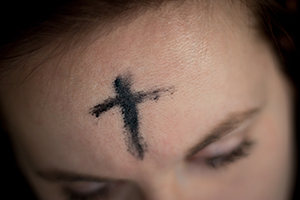
Lutherans go to church to receive ashes on Ash Wednesday as a reminder of their sinfulness, their mortality and that they have been redeemed.
Ash Wednesday derives its name from the placing of repentance ashes on the foreheads of participants at church observances with the words, “Repent, and believe in the Gospel” or “Remember that you are dust, and to dust you shall return”. Traditionally ashes are prepared by burning palm fronds from the previous year’s Palm Sunday celebrations in the Lutheran church.
Lutherans go to church to receive ashes on Ash Wednesday as a reminder of their sinfulness, their mortality and that they have been redeemed.
On Ash Wednesday, as Lent begins, Christians are invited “to struggle against everything that leads us away from the love of God and neighbour” by the “discipline of Lent” which involves repentance, fasting, prayer and works of love.
During Lent the church uses more reflective hymns and songs and omits the songs of praise and glory from the liturgy. The colours of the church and altar furnishings (paraments) and the pastors’ stoles are traditionally violet – a colour denoting seriousness and repentance.
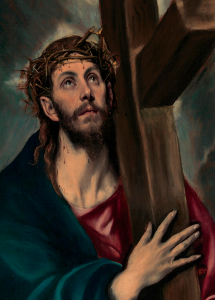
Christ carrying the cross with the crown of thorns, as painted by El Greco
In some churches, services of repentance are held with special emphasis on the story of our Lord’s Passion as told in the Bible, confession of sins and prayer.
Many churches advocate fasting during Lent. The following are some guidelines taken from the Rev Weitzel’s book that Lutherans may adopt as they seek to observe a Lenten fast:
- Fast on Ash Wednesday and Good Friday with only one simple meal during the day, usually without meat.
- Refrain from eating meat (bloody foods) on all Fridays in Lent, substituting fish for example.
- Eliminate a food or food group for the entire season. Especially consider saving rich and fatty foods for Easter.
- Consider not eating before receiving Communion in Lent.
- Abstain from or limit a favourite activity (television, movies etc.) for the entire season, and spend more time in prayer, Bible study, and reading devotional material.
- Don’t just give up something that you have to give up for your doctor, or diet anyway. Make your fast a voluntary self-denial (i.e. discipline) that you offer to God in prayer.

Palm Sunday … Christ’s entry into Jerusalem was witnessed by the crowds present who shouted praises and waved palm branches
The final week of Lent, or Holy Week, begins with Palm Sunday, also known as Passion Sunday. Traditionally, Palm Sunday commemorates Christ’s entry into Jerusalem described in all four gospels. As described in the accounts, Christ’s entry into Jerusalem was witnessed by the crowds present who shouted praises and waved palm branches. In Australia palm branches are placed in the church also, near the entry door. In some churches crosses are made from palm fronds and given to the congregation. After worship, the palms are taken away and burnt for the distribution of ashes during the following year’s Ash Wednesday service.
Lent culminates in the Triduum, the Three Sacred Days, which count the three days from sundown on Maundy Thursday to Easter sundown.
The Maundy Thursday service traditionally celebrates the Lord’s Supper, the Saviour’s love for all humankind, and his example in the washing of feet. The service concludes with stripping of the altar of all its furnishings to signify the stripping of Christ’s power and glory, and the veiling of the crucifix. If the service is in the evening, the church and the lights are extinguished. Worshippers then depart in silence.
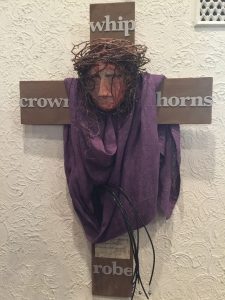
Many Christian churches observe the Stations on the Cross (or Via Crucis) on Good Friday. (St John’s Perth, WA)
Good Friday worship takes place in the austere church. There are no furnishings and no flowers, although some churches use black paraments on this solemn day. Some churches refrain from using music on Good Friday, but many use solemn music appropriate for the day.
Many Christian churches observe the Stations of the Cross (or Via Crucis) on Good Friday. It refers to a series of images depicting Christ’s journey to the cross in Jerusalem and marks the final hours in the life of Jesus Christ on earth. Worshippers journey along the path of the images, stopping at each station to reflect and pray. The Stations of the Cross serves as a stark reminder of the humility of Jesus, who was willing to set aside any privilege of deity in order to provide a path to salvation through his sacrifice. There are several different accepted versions of The Stations of the Cross, one being a traditional account, and one a Biblical account of the last hours of Christ and his subsequent death. There are usually 14 stations observed beginning with Jesus’ prayer on the Mount of Olives and ending with the laying of his body in the tomb.
Many churches observe an Easter Vigil on Holy Saturday. It was at this service where new believers were baptised or confirmed in the ancient Church.
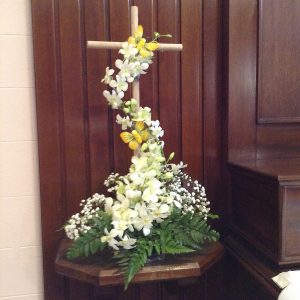
He is Risen indeed! Alleluia! (Bethlehem Adelaide, SA)
It is held in the hours of darkness between sunset on Holy Saturday and sunrise on Easter Day – most commonly in the evening of Holy Saturday or midnight – and is the first celebration of Easter, days traditionally being considered to begin at sunset.
The Easter Vigil is considered the most important liturgy of the liturgical year as it marks the first use of the exclamatory “alleluia”, a distinctive feature of the Easter season.
Many modern observances of this holy period omit the Easter Vigil, opting instead for an Easter sunrise service of joyful celebration.
The altar is once again furnished with the paraments in white, the paschal candle is lit and is used at every worship service during the Easter season. Flowers once more adorn the church which is filled with light in stark contrast with the solemnity of Good Friday.
In Lutheran churches, the pastor greets his congregation with the words “He is Risen!” and the congregation joyfully responds: “He is Risen indeed!” Alleluia!

